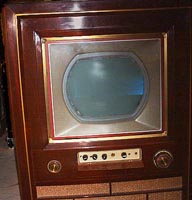THE SETEARLY COLOR TVThe Third Year June 2002 to June 2003 devoted to anything related to vintage color TV.   Thanks to Fred and his brother for creating this wonderful, machined sculpture of the original rectifier cage cover in my CT-100. To hold the piece is to be in the presence of history.... A number of covers -- both rectifier and H-V cage covers -- were made for collectors.  Six-pack of brand-new shiny under-vacuum 15GP22's in Lancaster PA where they were made as early as the fourth week of 1954. 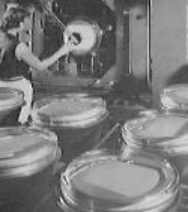  There's a list of known Westinghouse H840CK15 color sets on Marshall Wozniak's site.  This is about... In the early years of color when there were only b&w sets to watch, you could develop a sixth sense about shows produced in color with the TK-41. It wasn't hard to spot a color show on a b&w TV. There was a high-contrast look about the picture. One divined a color show because the picture was less sharp and the dark areas were heavier. But you could see in the mind's eye that a color set would decode those cryptic dark patches into chromatic clarity. On this site, there's an old picture of the only TK-41 I ever actually saw. And here, on page 12 of a book coauthored by video engineer Harry Kybett and me for Prentiss-Hall way back in 1982, is another milestone documenting my obsession with the TK-41. RCA was still a corporation when I called their publicity department in New York to get an official 8-by-10 glossy, from which the page 12 halftone was made. 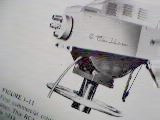 The exciting thing is... within the last two years or so, TK-41's have become part of three known private collections. Chuck Pharis is actively engaged in restoring one of the 300-pound beasties to operation! (How long has it been since we've seen an orbiter in operation?) Kris Trexler is expanding his great site that features high-quality graphics to now include, not only his personal TK-41, but great in-operation TK-41 photographs from the fifties and sixties.  Much thanks to Steve Dichter for this first-hand account of life with a TK-41. Hi Pete, Having started my broadcast career at KTLA-TV here in Los Angeles, I have much backbreaking hands-on experience with the TK-41. Needless to say, the TK-41's were huge. For remote broadcasts, the camera setup required four men to move the camera body, one on each corner. This after the large viewfinder housing had been removed and carried separately. The camera mounting cradle head took two men and all this was attached to a large tripod on wheels. Imagine the work involved setting up three of these behemoths and stringing hundreds of feet of extremely heavy cable from the truck to each camera. Then, lengthy engineering set-up time on a test pattern was required. We used these cameras into the late 70's when they were replaced with the Norelco Plumbicon cameras. Years later, I helped in the restoration of one of the KTLA TK-41 cameras, which is one of three located at the UCLA-TV archives, here in Los Angeles. KTLA started color broadcasting in 1954 with TK-40's. When I started in 1965, we had four TK-41's, which had replaced the TK-40's. The camera controls and control room were out of a huge Crown Coach bus. The TK-41's were used both in the studio and for remote operations. We actually had three Crown coaches, a control room bus, a video tape bus and a bus for storage and cable that carried the equipment. --Steve  PROFILES from the Living CT-100 List: -- the 72nd Merrill --  Where are they now? CT-100 was my very first color set. I purchased a demo model with 75 hours on it, absolutely perfect, for $75.00... delivered up 3 flights of stairs. This was in 1960. --Ward K.   ...through the magic of Corel Photo-Paint 8 (1) elation reminiscent of the exuberance of youth written on Steve Dichter's face. While, at the same time, keeping (2) the (more important!) 15GP22 image unaltered in this August 2002 landmark photograph.  Unedited Email But these are very close to what came off the modem.] From: Richard Emery Subject: 1954 RCA Victor CT100 Color Television Receiver Date: Mon, 23 Dec 2002 23:23:23 -0500 ----------------------------------------------------------------------------- A quote from Richard's email: "I've repaired sets for many years..." ----------------------------------------------------------------------------- The red video channel was literally burned out before I bought it from a TV dealer 15 years ago (there is a separate video circuit board for each of the three primary colors). Before that circuit failure, this CT-100 had been exhibited at fairs. I'm restoring the functionality of this set. The cabinet is in presentable condition. I'm worried about the picture tube. I never saw it operate. I'll find out soon how it works. The chassis was moved for repair from NH to my home in Massachusetts just yesterday. I've repaired sets for many years, but I may need help with rejuvenating the picture tube. I'll just let it run a couple of weeks to see if it comes back on its own. Otherwise, I will need new cathodes. I don't know who is installing custom cathodes (rebuilding all glass 15GP22 picture tubes) these days. ----------------------------------------------------- And here's the bulk of Richard's interesting email... ----------------------------------------------------- The 1954 (15-inch tube) and 1955 (metal 21-inch tube) were the only two RCA sets that had both true NTSC phosphors and full DC restoration in the same model. The 1954 model also has true I/Q color demodulation with more orange and cyan detail (three times as much horizontal resolution for these color hues) than that which can be seen on analog broadcasts in the most expensive home theater systems today. The 1.5 MHz " I " bandwidth is still on the FCC books for analog broadcasting, and NTSC / FCC "broadcast" cameras still have this wideband " I " feature today. All the one inch studio analog VTRs, and the studio digital composite D-2 and digital component D-1 format VTRs used in studios fully retain this extra "I" bandwidth. Likewise the digital 601 style digital studio wiring 4:2:2 for standard definition. Also, the Panasonic analog camcorder broadcast "M2" format. However, during the transition to MPEG-2, many analog stations loose (illegally, in my opinion) this extra bandwidth through second-rate and third-rate conversions between digital and analog. So ironically, in these modern times, we sometimes don't see all what these old TVs are capable of doing. The 1954 and 1955 models also have a true "Picture" control where both the luminance and chroma gain is tracked using ganged potentiometers internally. There is a separate color intensity control as well. This feature was gone in 1956. It took Sony in the 1970's to bring this "Picture" control feature back. The viewing screen on my 1954 model is also completely flat. To this day, I don't think RCA ever made another completely flat viewing screen. Starting in 1956, DC restoration was only partial. Also, due to gamma, the matrix in the picture tube trick (1956 and later) did not work completely right. This 1954 set corresponds to today's FCC recommended (not mandatory) 2.2 power law. The color difference signals in 1956 and later were 2.2 gamma while luminance was 2.7 gamma, which is not correct. When solid state sets came out, this erroneous signal processing approach was changed to a 2.7 power law, against the hopes of the NTSC and FCC. (Actually no one care's.) It's interesting that GE made a line of solid state TVs that also follow this 2.2 gamma curve simply by applying red, green, blue video to the picture tube control girds, just like what happens in my 1954 RCA. True NTSC phosphors were no longer available in 1962. After that, the color gamut was noticeably reduced, especially for all color combinations involving green. (But the overall light output increased.) Motorola reintroduced full DC restoration in their 1970 solid state models. Today, all sets have full DC restoration, but even the most expensive home theatre systems today don't have the wide true NTSC color gamut available in this original RCA color set. That's why many video product reviewers today think that the NTSC color gamut is not very large. They think they're looking at NTSC phosphors when, in reality, they aren't seeing any such thing. In reality, the NTSC gamut is actually larger than anything else ever was, including print AND film. On the old sets, (up through 1961) this is obvious if you turn up the color intensity even a little bit too much, or if unusual objects in nature or artificially generated appear in the scene. Also, with modern studio technology, these old sets perform far better than they ever could when they were new.  I keep a basic tally of the number of known Merrills on the Contributors Menu page. Here, sadly, is an August 2002 picture of a newly discovered Merrill, the third in the RIP category.  "With an extra yoke, you can work on your chassis on the bench without removing the yoke in the cabinet. Less chance to break your 15GP22 kine." --Jeff L.  15GP22 sockets From a March 2000 email by Tube Lore author Ludwell Sibley, here are insights for acquiring physical and electrical replacements for the 20-pin sockets and bases RCA used for the 15GP22 tricolor CRT. "Burle made some PMTs, photomultiplier tubes (type 6810A etc.), using the 20-pin header and base and might still have some RCA drawings around. Other companies made PMTs in the 1960s with the same 20-pin base and header: IT&T/Farnsworth (FW128, FW129, and FW130) and DuMont, who also made the 6810A. If you could live with a hard-pin base instead, EMI (their new name is something like Electron Tubes Ltd.), Hamamatsu, and Amperex should still have 20-pin headers available for their own use in PMT manufacturing along with mating Teflon and low-leakage phenolic sockets." In early 2008 a number of NIB type 20-PM connectors were unearthed. Click here .  15GP22 clones From yet another bit of recently unearthed color-TV history, here is conjecture about Zenith's early ties (albeit an apparently abbreviated association) with the development of the color CRT. In early 1954, the Thomas Electronics, Inc. company of Passaic, New Jersey proudly issued a 2-color brochure announcing the availability of two revolutionary cathode ray tubes for developmental purposes: the T.E.I. tricolor 15GP22 and the T.E.I. one-gun CH-22, an experimental Lawrence color CRT with a 72-degree deflection angle (vs. a squished 45 degrees for the 15GP22). We have no data as to the number of these tubes actually sold back then (probably very few, if any), but thanks to Dave Corbitt, whose associate unearthed this brochure in a Manhattan office recently, it is speculated that Zenith, or more directly, its subsidiary Rauland, supplied the 15GP22 to the still-today very-active Thomas Electronics company for private branding. Dave reports that in the fifties, Zenith supplied T.E.I. with cathode ray tubes. [In a 4 Feb 2003 email, Dave writes: TEI has been a major CRT manufacturer since 1948 and is still a major player in the specialty CRT business. However, TEI did market some CRTs built by Rauland (a Zenith division) back in the 50's including the two early color tubes in the brochure. Rauland did not make all of TEI's CRT's, just some tubes TEI was not geared up to manufacture such as the 15GP22 and the Lawrence tube. ] [In a 21 March 2008 email, Rich Mensinger, AKA polaraman, sent this amazing picture of a TEI 15GP22 in a company-built test fixture. He found the image in Reminisce magazine. Thanks Rich. 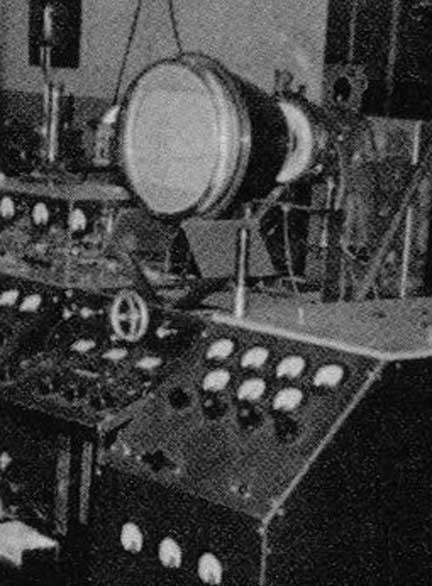
You can download a low-resolution pdf file of the TEI brochure. [Click Here to Download]   Unedited Email But these are very close to what came off the modem.] From: Mark To: dexnis60@yahoo.com Subject: CT-100 Website Date: Fri, 14 Feb 2003 14:08:02 -0500 Hi Pete, I have been visiting your website for over a year now, learning about the fabulous RCA CT-100 set. I am not an electronics expert, but I always am looking at interesting things. When I saw your website, it reminded me of something. I *think* that I almost had my hands on a CT-100 around six years ago. In Naperville, Illinois, there is an historic district in the middle of a college campus. I knew a friend of a friend who was renting one of these older houses, and I remember seeing a CT-100 when I was there, perhaps a total of three times. I am around 95% confidant that it was, because I remember looking at the small rounded screen and opening the pencil box. This set was in a basement party area, and I remember peeking at it, and it seemed complete. It did not have a power cord, because I asked if it was ever plugged in. This set cabinet was very beat up, but it had a tube. Sad part: I remember that the college kids gutted the set and turned it into an aquarium. I have no idea whatever happened to the chassis or cabinet, as it was years ago. I do know that the house was renovated and is no longer a rental house, so I am sure that it is all gone. Mark Aurora, IL  PROFILES from the Living CT-100 List: -- the 61st Merrill -- When I checked the unlit living room, I spotted a rather large mahogany TV cabinet. I carefully slid the now-obvious cabinet away from the wall. I couldn't believe it. The CT-100 was plugged in! The auctioneer was slowly making his way toward the living room. I tried to stay calm as the group of people entered the room. The auctioneer started crying for a bid on one thing then another. "Sold!" he said, "Sold!" time and again. Finally he came to the Merrill in the corner. "What do you want to bid for the old TV?" he shouted. Somebody snapped back with "$4.00!" The auctioneer said, "I've got $4.00! Will anybody make it five?" I quickly raised my hand but said nothing. "I got $5.00! Anybody make it $6.00? "I've got a $5.00 bid! "Six!" somebody shouted back. "I got $6.00! Anybody make it $8.00?" sang the auctioneer. What the heck happened to seven, I thought. "Eight," I said as I raised my hand into the air. "I got $8.00! Will anybody make it ten?" he said in succession. The room was quiet. Sold to the gentleman for $8.00." I couldn't believe it. I went to the clerk, paid my bill, and headed back to my house to get a dolly to cart my treasure home. When I got it home, I noticed that it was missing one knob… the channel selector. My memory went back to 1953 when our family had an RCA b&w set that was missing its channel selector knob. My dad had fitted the channel shaft with a small C-clamp to replace the knob. Would I be using a C-clamp to replace the missing knob on the CT-100? No, I don't think so! That was over twenty years ago. The CT-100 was working like new back in 1995 when we moved and it went into storage in Indiana. I still haven't found a knob to replace that missing channel selector knob. --Terry Cheek Since I received this email from Terry a year ago, he and his son have recovered the Merrill from storage in Indiana, and he is in the process of returning the set to operation at his North Carolina home. He recently acquired the channel knob on ebay. --Pete (March 2003)  Unedited Email But these are very close to what came off the modem.] To: dexnis60@yahoo.com Subject: 1936 HMV Date: Mon, 19 May 2003 22:59:24 +0100 Dear Pete One of these days when I'm over in the States I shall get to see a CT-100 for myself, but in the meantime I shall content myself with visiting your excellent site. Alas we technologically-challenged Brits didn't have colour TVs for sale in the stores until the mid-1960s, and apart from test transmissions a full colour service wasn't available until 1967. But maybe this will make you a teeney bit jealous. Recently I got to see the very first TV set produced by HMV in 1936 -- literally the very first set off the very first production run of the first model for sale to the public. It's owned by Gerald W. in London, who also just happens to have an old BBC standards converter. And the set still works! I persuaded Gerald to power it up. For the first time in nearly thirty years I was watching a real 405-line picture complete with that quaintly old-fashioned phosphor hue. In fact it was an astonishingly good picture. Best of all I realized that my hearing hasn't lost its ability to hear the 405-line oscillator. That good old whistle was there just like it used to be before 625 lines finally became the only standard. I thought I'd gone to heaven! Best wishes, Jonathan Rogers, London  How many color television sets can fit into one museum? I have no idea! But here are two questions that lead to a fascinating experience in vintage 1954 color television. [click here]  PROFILES from the Living CT-100 List: -- the 76th Merrill -- A tale of shady color... Well I finally got down to Southern California and took a peek at my CT-100 there. The top and cabinet numbers are 538 and the chassis number is B8003196. The set has a past. Years ago I bought it from a guy who gave TV men a cloudy name. We both sold "recycled" color TV sets back when color was special, but he and I had a different set of values. Those “other” values included sales techniques such as bait-and-switch and come-on advertising. Of course, they would use rebuilt picture tubes as we all did, but most shops would use a "first" or a "second,” whereas they would use anything that would light up. For example, a "third" is a pretty bad tube cosmetically, but some guys used a lot of them as well as "fourths" and I even saw a "fifth," which was so bad that the whole lower left side was purple along with purple dots on the rest of the screen. Believe it or not, the rebuilders paid to take them so they could get a rebuildable dud! Dale Rice Dale writes: 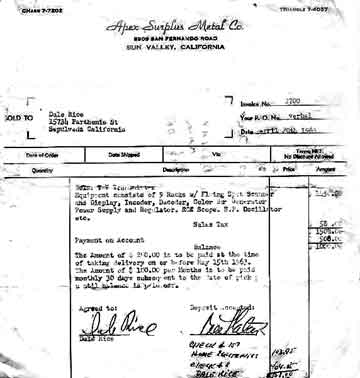 Recently, I ran across this old invoice. It’s for a machine I bought in the early days of color when there was very little color programming. You must realize what kind of a color TV nut I was when you consider my age and the 1,450 1963-dollars I spent on this thing in a $2 an hour job. This machine was scrapped out by Capehart-Farnsworth who used it in their development of color receivers. I only fired this thing up once (so far!) but it worked. It uses dichroic mirrors and photomultiplier tubes to scan 35mm slides. Three specially phosphored 10-in. CRTs and dichroic mirrors are used in the color monitor.  
|

